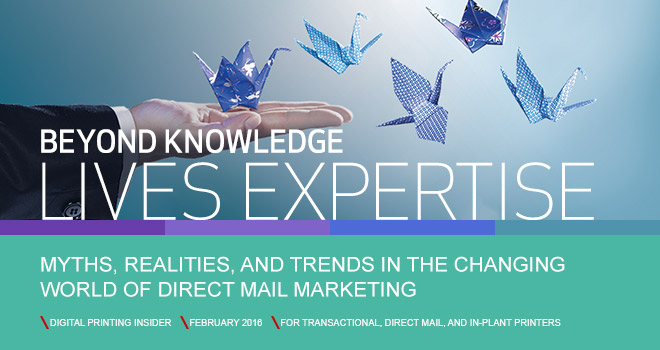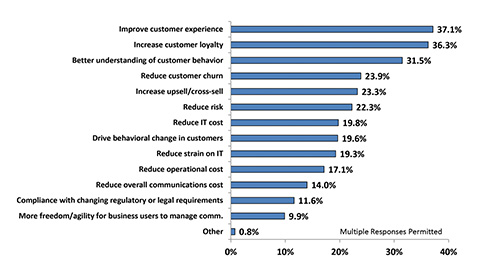Direct Mail Delivers: Strategies for Participating in the Value Chain
Marketers of all sizes are coming to the realization that direct mail delivers. Direct mail is an integral part of the overall marketing mix. It’s a vital for acquiring new customers, retaining existing ones, and reactivating dormant accounts.
“Here’s the truth about direct mail: It’s not dying, it’s just changing,” says Ginger Conlon, Editor-in-Chief of Direct Marketing News in the Canon Solutions America-sponsored webinar entitled Direct Mail Delivers: Strategies for Participating in the Value Chain presented by Printing Impressions and In-plant Graphics magazines. Moderator of this webinar, InfoTrends Group Director Barb Pellow, uses various data to support Conlon’s claims. According to Winterberry Group, direct mail spending grew 2.7% in 2014 and a further growth rate of 1.1% is anticipated in 2015. This means that direct mail spending will top $45.7 billion in 2015. “What we’re seeing is that direct mail is clearly pivotal,” Pellow adds.
Together in this webinar, Pellow and Conlon discuss how the resurgence in direct mail has resulted in a few key trends that are worth taking note of in the new year. Strategies outlined in the session include delivering a great customer experience and creating the right multi-channel atmosphere. Further, Conlon, debunks some of the most common direct mail myths and makes recommendations on how to respond to their realities.
The resurgence in direct mail has resulted in a few key trends that are worth taking note of in the new year. Strategies … include delivering a great customer experience and creating the right multi-channel atmosphere.
Delivering a great customer experience starts with understanding what your customers want and taking action to deliver it, explains Pellow. The hard part is taking what you’ve learned and adjusting the way your company works so that your teams, processes, and technologies are capable of delivering on the experience that the customer expects. According to InfoTrends’ 2015 study entitled Customer Engagement Technologies: The State of the Market, North American and western European enterprises’ top objective for communication investments was improving the customer experience.
The days of high-level, single-channel marketing campaigns are long gone. With the proliferation of media channels in today’s world, marketers are faced with more options than ever when considering how to reach consumers. Marketers must make choices about channels, but a heavy investment in one channel may cause them to miss the potential in another. Today’s consumers have all channels turned on — they are in control of how they gather information, obtain advice from friends and family members in their social networks, and complete transactions with suppliers. This result is a new set of rules for marketers and a new buzzword that print providers must understand and add to their vernacular … omni-channel.
A key message that print service providers must convey to customers is that print remains an integral part of the overall marketing mix. After experimenting with digital only, many marketers have returned to print and are producing catalogs, newsletters, postcards, and brochures. They are using print to improve customer acquisition and drive customers to other channels, but it’s also a durable and shareable media for delivering valuable information.
Conlon expands on Pellow’s assessment of the current state of the direct mail market. She reports on the numerous reasons and opportunities that direct mail is providing to various businesses and industries. According to research findings from The Direct Marketing Association, the response rate for targeted direct mail is 4.3% while the e-mail response rate is only 0.12%. “Take notice of the word “targeted” in that last sentence — targeting direct mail, whether through personalization or a segmented list, is what makes the connection,” comments Conlon.
After her in-depth discussion on its current state, Conlon dives into some of the most common direct mail myths and realities. “Direct mail (supposedly) is … cost-prohibitive, old school, not for the digital age, ineffective, and a hassle. But I say, not so fast!” declares Conlon. Talking through each of these myths, Conlon provides detailed insights and examples that disprove these myths. She uses detailed examples from both traditional and digital companies and from various industries to make the case for the thriving direct mail industry. While uncovering these truths, Conlon also provides actionable strategies to tackle these realities and create the highest returns available.
“One of the best things you can do is to be the expert,” Conlon recommends. Help your customers to send the right messages and to the right people. Get involved sooner. Figure out postage before design. These are just a few of the ways that you can increase your value, and they are just a few of the strategies Conlon covers in this webinar.
Marketers need help; they are seeking good direct mail partners to help them. Direct mail is changing, and service providers’ expectations are evolving as well. Today, your customers are seeking additional help with improving the customer experience through the use of data analytics and strategy for relevant multi-channel communications. Direct mail is a pivotal link in the marketing mix, and it’s time to pay attention to how direct mail delivers results! Join Barb Pellow and Ginger Conlon in this exciting webinar as they provide valuable insight and expose strategies for using direct mail effectively in the new year.

